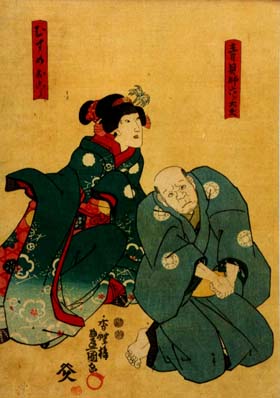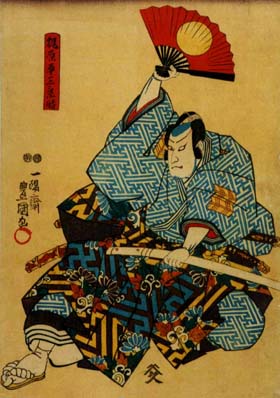| ISHIKIRI KAJIWARA |
| Play titles |
Miura no ďsuke K˘bai Tazuna Kajiwara Heiz˘ K˘bai Tazuna Kajiwara Heiz˘ Kitai no Ishikiri Kajiwara Heiz˘ Homare no Ishikiri The Stone-Cutting Feat of Kajiwara Heiz˘ Kajiwara Heiz˘ Tameshi no Wazamono Na-mo Tachibana Homare no Ishikiri |
| Common title | Ishikiri Kajiwara |
| Authors | Hasegawa Senshi Matsuda Bunk˘d˘ Kanazawa Ryűgoku I (1821) |
| History |
The drama "Miura no ďsuke K˘bai Tazuna" was originally written for the puppet theater (Bunraku) and staged for the first time in the 2nd lunar month of 1730 in ďsaka at the Takemotoza. It was adapted for Kabuki a fews months later and staged for the first time in the 8th lunar month of 1730 at the Kado no Shibai. It was staged for the first time in Edo in the 6th lunar month of 1795 at the Kiriza [casting]. Then, it went into oblivion for more than 2 decades. It was revived by the Kamigata star Nakamura Utaemon III, who revised the script for the third act under his pen name of Kanazawa Ryűgoku I. It became an independent drama, staged in the 3rd lunar month of 1821 at the Kado no Shibai under the title "Kajiwara Heiz˘ K˘bai Tazuna" [casting] and in the 11th lunar month of 1822 at the Kitagawa no Shibai under the title "Kajiwara Heiz˘ Kidai no Ishikiri" [casting]. The title "Kajiwara Heiz˘ Homare no Ishikiri" was used for the first time in the June 1892, in Nagoya at the Suehiroza. From the end of the 19th century, 3 stars contributed to popularize and magnify the role of Kajiwara Heiz˘ Kagetoki: Nakamura Ganjir˘ I (first time in November 1896 at the Naniwaza), Nakamura Kichiemon I (first time in November 1905 at the Kabukiza) and Ichimura Uzaemon XV (first time in February 1919 at the Kabukiza). |
| Structure |
The drama "Miura no ďsuke K˘bai Tazuna" was made up of 5 acts and its most famous scene, which was the final one in the third act (kiri), became an independent drama staged on different titles, the most famous one being "Kajiwara Heiz˘ Homare no Ishikiri". This scene is commonly called "Ishikiri Kajiwara" (literally 'stone-cutting Kajiwara'). The role of Kajiwara is one of the finest examples of sabakiyaku, belonging to the Kak˘shű collection of dramas set by the star Ichimura Uzaemon XV |
| Key words |
Aogaishi Ch˘zubachi Genpei Kassen Genpei-kassenmono Genji Gidayű Ky˘gen Giri/Ninj˘ Heike Ishibashiyama no Tatakai Jidaimono Kajiwara Kagetoki Kak˘shű Katana Kiri Matano Kagehisa Minamoto Yoritomo Minamoto Yoshitsune Monogatari ďba Kagechika Sabakiyaku Tameshigiri Tsurugaoka Hachimangű |
| Summary |
ďba Sabur˘ and his bombastic villainous brother Matano Gor˘, who are both Heike warriors, are at a shrine in Kamakura celebrating their recent victory over the enemy general, Yoritomo, when Kajiwara Kagetoki, who also fought in the same battle, enters and joins them. An elderly man and his daughter then appear and approach ďba. Old Rokur˘dayű wishes to sell a precious sword in his possession to help his daughter Kozue, and asks ďba to buy it. Just as ďba is about to go ahead, his brother objects and says that before anyone parts with 300 gold pieces he wants the sword examined. Kajiwara, who is known to be an outstanding swordsman, agrees to examine the sword. As he does so, he notices not only its excellence but sees something on the hilt that indicates the sword is a treasure of the enemy Genji, but he keeps that information silent. Kajiwara gives the sword his unqualified approval, and the sale is about to through again when Matano says that if it doesn't cut well it is more useless than a rusty fish knife, and insists that it is tested-by cutting two condemned prisoners in half. The prison official reports that unfortunately there is only one prisoner currently under the death sentence, so ďba says that he cannot buy the sword and readies himself to leave. Rokur˘dayű, however, is desperate to sell the sword because he is secretly a Genji sympathizer and he needs the money to give to the Genji cause, so he offers himself as the second body, on the understanding they give the money to his daughter after his death. Matano is satisfied and plans to do the slicing himself, but Kajiwara intervenes and says he will test the sword. The condemned man is brought in and lain on top of Rokur˘dayű. Kajiwara brings down the sword with precision, but only the criminal is killed. Rokur˘dayű is still safely in one piece. Matano is disgusted that the sword has failed its reputation and leaves with ďba. Kajiwara then reveals that he deliberately gauged the power of his stroke so that Rokur˘dayű would not die. He, Kajiwara, recognizes the power and significance of the sword, and will buy it for himself, for he is also secretly a Genji sympathizer. And to prove the sword is in no way defective he brings it down on a stone water trough, cutting it clean in two. All three are delighted with the outcome and leave for Kajiwara's mansion to settle payment. Courtesy of Jean Wilson (1999) |
| Comments |
"The role of Kajiwara is particularly demanding because he has to appear to be a loyal Heike warrior while showing the audience he secretly sympathizes with the Genji and is moved by Rokur˘dayű's plight." (Jean Wilson) "Kajiwara Kagetoki is an historical figure and appears in a number of the plays about Yoritomo and Yoshitsune. He was a notable Taira warrior who did, in fact, desert from his own side and join Minamoto Yoritomo. It is this change of allegiance, or "double-heartedness" as it is termed in Kabuki, which is the fundamental theme of the play. The incident which finally made Kajiwara decide to join the Minamoto is pure drama. Yoritomo had been forced by circumstances to appear in open rebellion some months before he actually planned to do so. As a result, he had very few adherents and crossed the Hakone pass to advance on Sagami in September 1180, with only three hundred men. He was confronted at Ishibashiyama by ďba Kagechika (who appears in the play) with a force of over three thousand and, after a desperate fight, was defeated. Yoritomo escaped into the hills and one of those sent out to hunt for him was Kajiwara Kagetoki. At one moment, when his pursuers were close at his heels, Yoritomo hid inside a hollow tree. Kajiwara looked into the tree, saw whom it contained and, telling his men there was no one there, directed the search away from Yoritomo's hiding place. A couple of months later Yoritomo, now at the head of twenty thousand men, was able to march upon Kamakura, where ďba Kagechika had his headquarters. It was at this time that Kajiwara joined him. ďba Kagechika was driven from Kamakura and for the first time Yoritomo established himself in what afterwards became his capital. Kajiwara became one of his most trusted advisers and served him with devotion to the end of his life." (Aubrey and Giovanna Halford in "The Kabuki Handbook") |
| Trivia |
The title of the play may change depending on the actor. It is entitled "Kajiwara Heiz˘ Tameshi no Wazamono", not "Kajiwara Heiz˘ Homare no Ishikiri", when the role of Kajiwara Heiz˘ Kagetoki is played by an actor belonging to the Nakamura Ganjir˘ line. It is entitled "Na-mo Tachibana Homare no Ishikiri", not "Kajiwara Heiz˘ Homare no Ishikiri", when the role of Kajiwara Heiz˘ Kagetoki is played by an actor belonging to the Ichimura Uzaemon line. |
 |
 |
|
The actors Onoe Baik˘ IV, ďtani Tomoemon IV and Arashi Kichisabur˘ III, playing the roles of Kozue, Rokur˘dayű and Kajiwara Kagetoki in the drama "Kajiwara Heiz˘ K˘bai Tazuna", which was staged in the 1st lunar month of 1850 at the Ichimuraza (print made by Utagawa Toyokuni III) |
|
|
|
| Contact | Main | Top | Updates | Actors | Plays | Playwrights | Programs | Links | FAQ | Glossary | Chronology | Illustrations | Prints | Characters | Derivatives | Theaters | Coming soon | News |